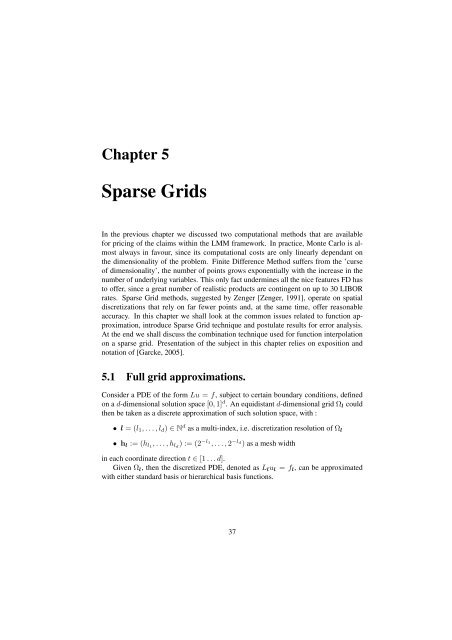sparse grid method in the libor market model. option valuation and the
sparse grid method in the libor market model. option valuation and the
sparse grid method in the libor market model. option valuation and the
You also want an ePaper? Increase the reach of your titles
YUMPU automatically turns print PDFs into web optimized ePapers that Google loves.
Chapter 5<br />
Sparse Grids<br />
In <strong>the</strong> previous chapter we discussed two computational <strong>method</strong>s that are available<br />
for pric<strong>in</strong>g of <strong>the</strong> claims with<strong>in</strong> <strong>the</strong> LMM framework. In practice, Monte Carlo is almost<br />
always <strong>in</strong> favour, s<strong>in</strong>ce its computational costs are only l<strong>in</strong>early dependant on<br />
<strong>the</strong> dimensionality of <strong>the</strong> problem. F<strong>in</strong>ite Difference Method suffers from <strong>the</strong> ’curse<br />
of dimensionality’, <strong>the</strong> number of po<strong>in</strong>ts grows exponentially with <strong>the</strong> <strong>in</strong>crease <strong>in</strong> <strong>the</strong><br />
number of underly<strong>in</strong>g variables. This only fact underm<strong>in</strong>es all <strong>the</strong> nice features FD has<br />
to offer, s<strong>in</strong>ce a great number of realistic products are cont<strong>in</strong>gent on up to 30 LIBOR<br />
rates. Sparse Grid <strong>method</strong>s, suggested by Zenger [Zenger, 1991], operate on spatial<br />
discretizations that rely on far fewer po<strong>in</strong>ts <strong>and</strong>, at <strong>the</strong> same time, offer reasonable<br />
accuracy. In this chapter we shall look at <strong>the</strong> common issues related to function approximation,<br />
<strong>in</strong>troduce Sparse Grid technique <strong>and</strong> postulate results for error analysis.<br />
At <strong>the</strong> end we shall discuss <strong>the</strong> comb<strong>in</strong>ation technique used for function <strong>in</strong>terpolation<br />
on a <strong>sparse</strong> <strong>grid</strong>. Presentation of <strong>the</strong> subject <strong>in</strong> this chapter relies on exposition <strong>and</strong><br />
notation of [Garcke, 2005].<br />
5.1 Full <strong>grid</strong> approximations.<br />
Consider a PDE of <strong>the</strong> form Lu = f, subject to certa<strong>in</strong> boundary conditions, def<strong>in</strong>ed<br />
on a d-dimensional solution space [0, 1] d . An equidistant d-dimensional <strong>grid</strong> Ω l could<br />
<strong>the</strong>n be taken as a discrete approximation of such solution space, with :<br />
• l = (l 1 , . . . , l d ) ∈ N d as a multi-<strong>in</strong>dex, i.e. discretization resolution of Ω l<br />
• h l := (h l1 , . . . , h ld ) := (2 −l 1<br />
, . . . , 2 −l d<br />
) as a mesh width<br />
<strong>in</strong> each coord<strong>in</strong>ate direction t ∈ [1 . . . d].<br />
Given Ω l , <strong>the</strong>n <strong>the</strong> discretized PDE, denoted as L l u l = f l , can be approximated<br />
with ei<strong>the</strong>r st<strong>and</strong>ard basis or hierarchical basis functions.<br />
37
















